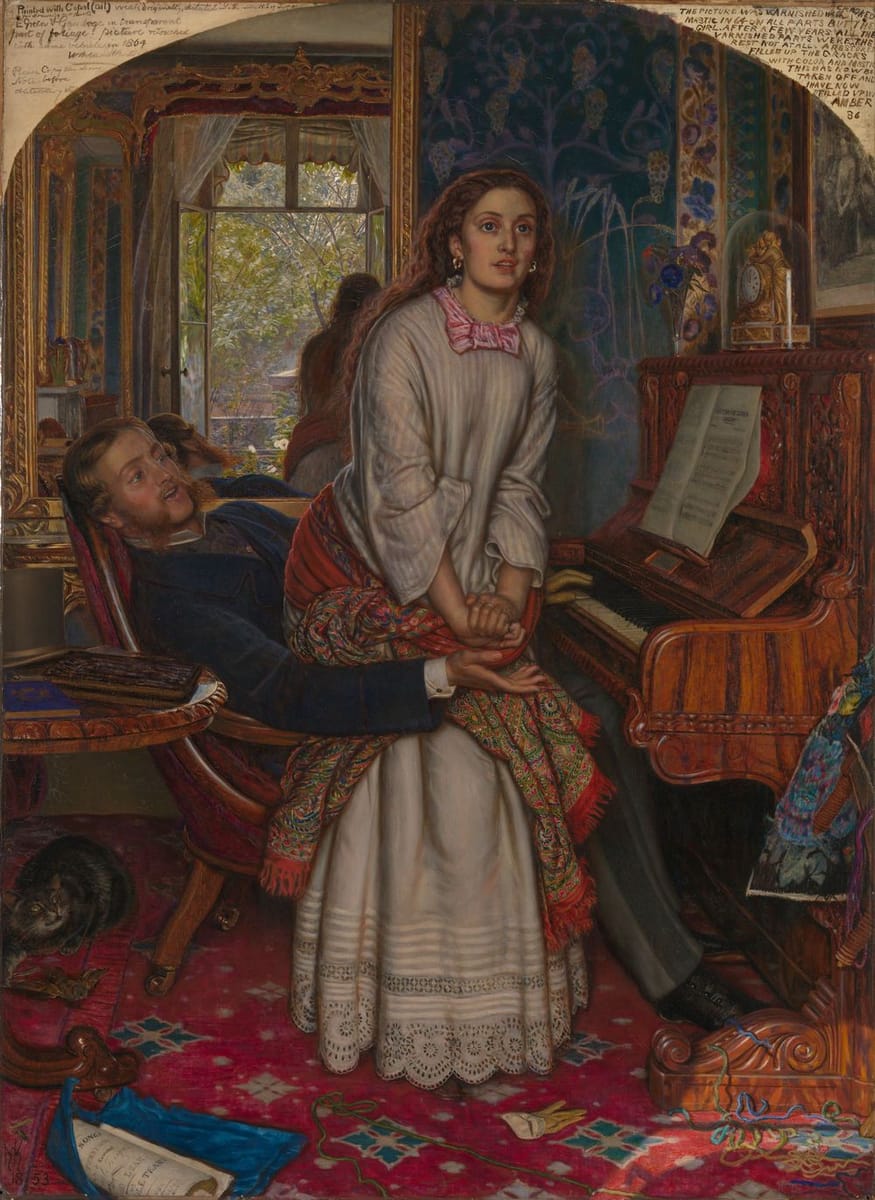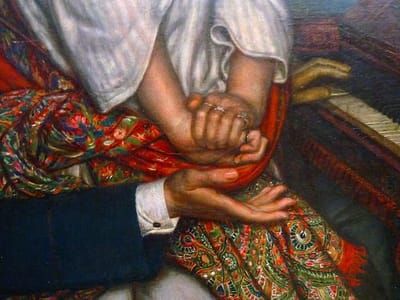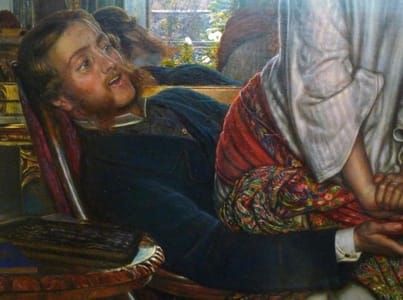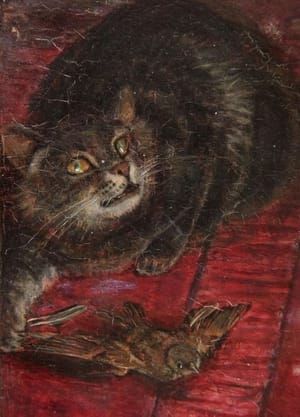

The Awakening Conscience, 1853
William Holman Hunt
Among the lush and gorgeous Victorian art movement known as the Pre-Raphaelite Brotherhood were artists who not only painted narrative paintings, that is paintings that tell a complex situation in their details, but more so and more novelly, did so using original scenes.
In other words, painting a scene in which, by examining the details, one can work out an entire narrative was nothing new. But these scenes were always well known events. In Victorian times these events were obsessively biblical. You can find hundreds of detailed scenes on biblical events. But William Holman Hunt, one of the founding members of the Pre-Raphaelite Brotherhood who as a group stressed a return to abundant detail, intense colors, and complex compositions started doing something even more daring, he painted scenes with narrative that he just made up himself....
So what’s happening here?
This woman is the man’s mistress, a kept woman with no money of her own. He is using her for hanky panky, has no intention of ever marrying her, and she is utterly dependent upon him and when he tosses her aside, as he absolutely will, she will likely end up an alcoholic prostitute. Basically she is like Fantine in Les Miserables just before she is pregnant and tossed aside by her callous, deflowering lover. However, unlike Fantine, this woman is having a spiritual epiphany right this moment, one that is likely to cause her to change her life, her situation, certainly get rid of this bum, and live a virtuous life.
We know all this because the details in the painting tell us all this and more. Let me demonstrate:
She has rings on all her fingers except the ring finger. So she’s unmarried, sitting on this guy’s lap AND wearing a sleeping gown. The hat on the table says the man is a visitor and not a permanent resident.This makes the young woman clearly the man’s mistress, not a young maiden he’s courting for marriage.
The objects around them fill everything in. The cat is toying with a bird and both are in a the same perspective as the woman and the guy. This signifies the man is toying with the woman with the same callow disregard. However, just like woman, the cat’s been distracted by something (probably the young woman standing up so abruptly), and the bird has a chance to escape.
A tapestry hangs unfinished on the piano, the threads of which lie unraveled on the floor; also lying discarded on the floor is a musical arrangement of Tennyson’s poem “Tears, Idle Tears”; on the piano is the sheet music for a well-known song at the time, Thomas Moore’s Stilly Night”, the lyrics of which speak of missed opportunities and sad memories of a happier past. A soiled, discarded white glove on the floor symbolizes the woman’s fate if she stays with her lover. The picture on the wall shows the biblical story of the women taken into adultery. A print of Frank Stones’s Cross Purposes is on the wall.
Many of these details clearly would not be recognizable to a modern audience but would be obvious to a Victorian one. Here is an especially poignant one: “The room is too cluttered and gaudy to be in a Victorian family home; the bright colors, unscuffed carpet, and pristine, highly-polished furniture speak of a room recently furnished for a mistress. Art historian Elizabeth Prettejohn notes that although the interior is now viewed as “Victorian” it still exudes the “‘nouveau-riche’ vulgarity” that would have made the setting distasteful to contemporary viewers. The painting’s frame is decorated with further symbols: bells (for warning), marigolds (for sorrow), and a star above the girl’s head (a sign of spiritual revelation).”
However, the woman is rising. Literally rising. The centerpiece of the entire painting is actually not the woman, it’s something beyond the room, beyond the woman, beyond the situation, it’s a shining light of natural beauty, and nature to the Pre-Raphaelites symbolizes morality and truth.The natural world, in all its splendor, is calling to the young woman with an offer of redemption. Plus, the painting is called, you know, The Awakening Conscience. So there’s that clue too.
And here’s a killer detail: The model for the image of the young lady? Well, it was actually Holman Hunt’s own mistress, Annie Miller. Hunt was trying to convince Miller to leave behind her life as a mistress, and reform herself into a good woman of society he could marry with dignity. She never did take to this idea of becoming his Good Wife and they eventually broke up.
[https://steampunkopera.wordpress.com/2012/07/11/narrative-painting-the-awakening-conscience/]
See also: https://www.khanacademy.org/humanities/becoming-modern/victorian-art-architecture/pre-raphaelites/v/william-holman-hunt-the-awakening-conscience-1853
Uploaded on Oct 22, 2016 by Suzan Hamer
Arthur
coming soon




